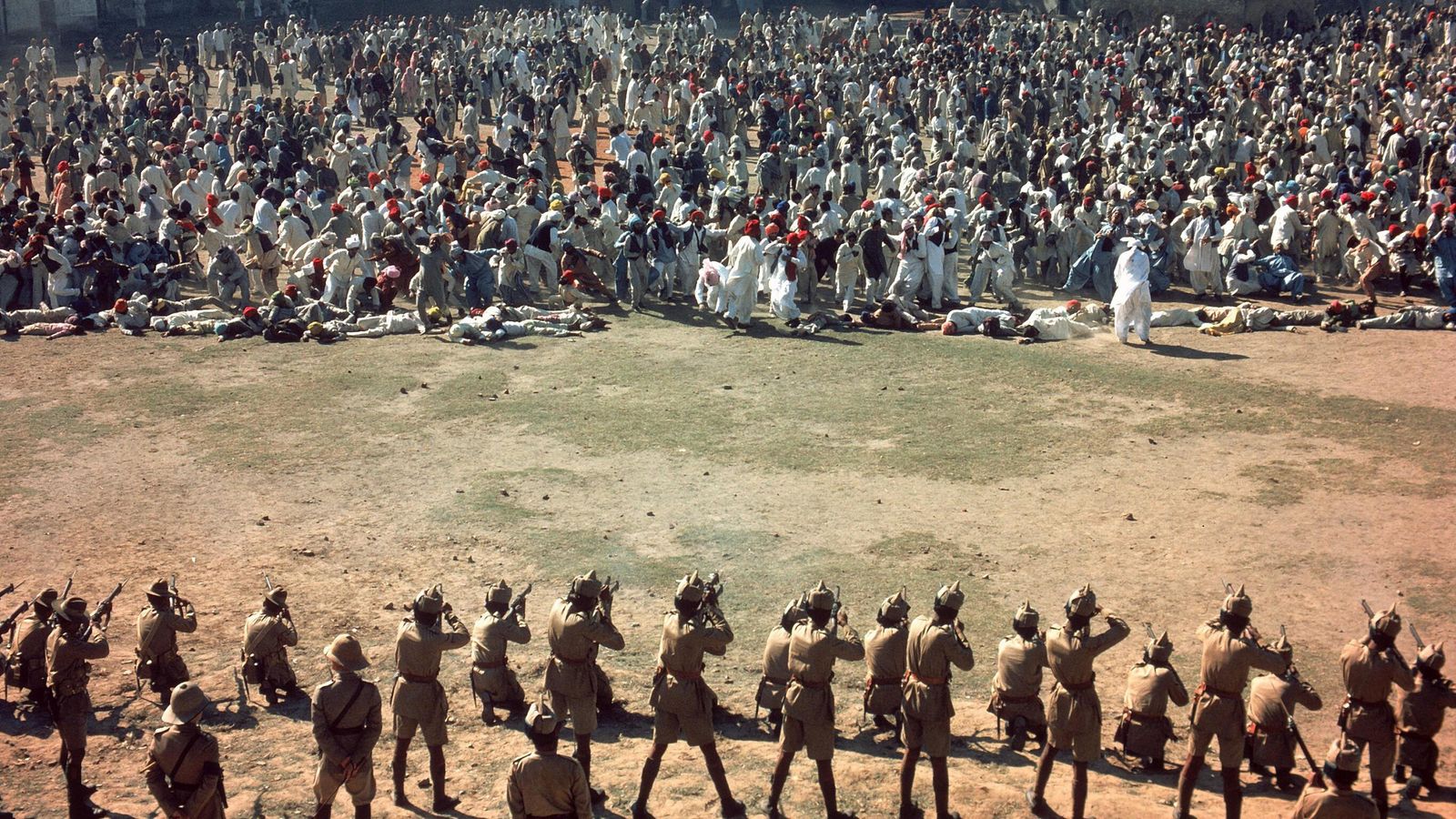Jaswant Singh Chail, who attempted to assassinate the late Queen Elizabeth II with a crossbow on Christmas Day in 2021, has been sentenced for treason at the Old Bailey.
The court has heard that Chail told a doctor after his arrest that it was his “life purpose” to assassinate the late Queen “principally to avenge the Amritsar massacre”.
“He [Chail] considered that the killing of the figurehead of the British Empire would be a suitable act in retribution,” said prosecutor Alison Morgan KC.
The Jallianwala Bagh massacre took place on 13 April 1919, when British Indian Army troops opened fire on thousands of people who had gathered in the city of Amritsar in India, killing an estimated 379 people and injuring 1,200.
It’s been described as one of the worst atrocities of colonial rule – but what exactly happened and why?
A peaceful movement turns violent
In March 1919, the British government passed a highly controversial piece of legislation which became known as the Rowlatt Act.
India floods: 14 dead and 100 missing after sudden rainfall swamps several towns
Hardeep Singh Nijjar: US urges India to cooperate with probe into killing of Sikh separatist in Canada
Humans of New York creator Brandon Stanton slams Indian version over copyright row
The act essentially extended measures from World War I and granted the government the power to imprison citizens of British India suspected of “terrorist” activities for up to two years without trial.
The purpose of the legislation was “for the British to stay in control”, says Rav Singh, founder of A Little History Of The Sikhs.
“A central strategy of the Rowlatt Act was to either contain or remove individuals involved with anti-colonial movements, rather than acknowledge legitimate grievances or any political agenda,” he says.
In response to the new policies, a nationwide hartal (suspension of work) was called by anti-colonial nationalist Mahatma Gandhi on 6 April 1919.
But within a couple of days, what was set out to be a peaceful movement turned violent when two prominent Indian leaders – Dr Saifuddin Kitchlew and Dr Satyapal – were arrested and banished in Amritsar for organising protests against the legislation.
Retaliation from both sides sparked rioting, during which British banks and people were targeted and British lives were lost. Widespread anger and discontent started to grow throughout India.
The outbreak of violence had become so intense that Colonel Reginald Edward Harry Dyer, a British brigadier general, who was brigade commander at Jalandhar (southeast of Amritsar) moved his troops to Amritsar to restore order there.
Punjab was put under martial law, meaning it became unlawful for more than four people to assemble at a place.
However, it was Dyers’ commands that led 13 April 1919 to become the one date in the history of British India impossible to ignore.
13 April 1919
On 13 April 1919, thousands gathered at Jallianwala Bagh, a public garden in Amritsar, to celebrate the popular Sikh festival of Vaisakhi and to protest against the act.
Dyer arrived with his troops, blocked the only narrow entrance to the garden and gave the order to open fire at the unarmed crowd, without warning.
The indiscriminate firing went on for about 10 minutes until 1,650 rounds of ammunition were exhausted.
The official count of deaths reached months later was 379 – however, the actual number killed is believed to be much higher.
Sir Michael O’Dwyer
Sir Michael Francis O’Dwyer was a colonial officer in the Indian Civil Service (ICS). The Amritsar massacre occurred during his tenure as the Lieutenant Governor of Punjab in British India
A few months after the attack, it was revealed in an inquiry that Sir Michael had endorsed Dyer’s actions at Jallianwala Bagh by sending him a telegram a day after the massacre which read: “Your action correct. Lieutenant Governor approves.”
Over 20 years after the massacre, Sir Michael was assassinated by Udham Singh – a campaigner for Indian independence – who shot and instantly killed the former Punjab governor at a meeting in Caxton Hall, Westminster.
Singh explained to the judge during his trial: “I did it because I had a grudge against him, he deserved it.”
On 31 July 1940, Udham Singh was hanged at Pentonville Prison and India gained independence seven years later.
Is there still anger?
Chail’s attempt to assassinate the late queen as revenge for the Amritsar massacre begs the question of whether there’s still anger within the communities affected.
Queen Elizabeth II visited Jallianwala Bagh in 1997 to pay tribute to the dead, but no apology was offered.
Though Dyer was forced into retirement after the inquiry, many still feel that blaming what happened on one man undermines the idea that it was the colonial system that was at fault.







